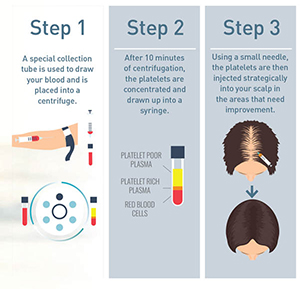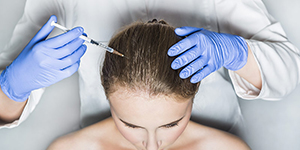
PRP For Hair

What is PRP therapy?
PRP (platelet-rich plasma) therapy for hair loss is a three-step medical treatment in which a patient’s blood is drawn, processed, and then injected into the scalp.
Some in the medical community think that PRP injections trigger natural hair growth and maintain it by increasing blood supply to the hair follicle and increasing the thickness of the hair shaft. Sometimes this approach is combined with other hair loss procedures or medications.
There has not been enough research to prove if PRP is an effective hair loss treatment.
Although there hasn’t been much scientific research done on PRP for hair loss, PRP therapy has been in use since the 1980s. It has been used for problems such as healing injured tendons, ligaments, and muscles.
PRP therapy process
PRP therapy is a three-step process. Most PRP therapy requires three treatments 4–6 weeks apart. Maintenance treatments are required every 4–6 months.
Step 1 :-
Your blood is drawn — typically from your arm — and put into a centrifuge — a machine that spins rapidly to separate fluids of different densities.
Step 2 :-
After about 10 minutes in the centrifuge, your blood will have separated into in three layers:
- platelet-poor plasma
- platelet-rich plasma
- red blood cells

Step 3 :-
The platelet-rich plasma is drawn up into a syringe and then injected into areas of the scalp that need increased hair growth.
There hasn’t been enough research to prove whether PRP is effective. It’s also unclear for whom — and under what circumstances — it’s most effective. According to a recent study, “Although PRP has sufficient theoretical scientific basis to support its use in hair restoration, hair restoration using PRP is still at its infancy. Clinical evidence is still weak.”

PRP for hair loss side effects
Because PRP therapy involves injecting your own blood into your scalp, you aren’t at risk for getting a communicable disease. Still, any therapy that involves injections always carries a risk of side effects such as:
- injury to blood vessels or nerves
- infection
- calcification at the injection points
- scar tissue
There is also the chance that you could have a negative reaction to the anesthetic used in the therapy. If you decide to pursue PRP therapy for hair loss, let your doctor know in advance about your tolerance to anesthetics.
Risks of PRP for hair loss
Be sure to report all medications you are on before the procedure including supplements and herbs. When you go for your initial consultation, many providers will recommend against PRP for hair loss if you:
- are on blood thinners
- are a heavy smoker
- have a history of alcohol or drug abuse
- scar tissue
You might also be rejected for treatment if you have been diagnosed with:
- acute or chronic infections
- cancer
- chronic liver disease
- chronic skin disease
- hemodynamic instability
- hypofibrinogenemia
- metabolic disorder
- platelet dysfunction syndromes
- systemic disorder
- sepsis
- low platelet count
- thyroid disease
How much does PRP for hair loss cost?
PRP therapy typically consists of three treatments in a 4–6 week period, with maintenance treatments every 4–6 months. The price typically ranges from 5000 to 8000 per sitting.
Many insurance plans consider PRP for hair loss treatment to be “cosmetic” and don’t cover any of the costs of the treatment. Check with your insurance provider to see if PRP therapy is covered for you.
Takeaway
If you’re concerned about hair loss, you have a number of options including medication like Rogaine and Propecia, and hair transplant surgery. Another consideration is PRP therapy.
Although there is limited clinical proof that PRP for hair loss works, there are many who believe that PRP is a safe and effective way of reversing hair loss and stimulating new hair growth. Talk to your doctor to see which treatment or combination of treatments is the best choice for (PRP).




